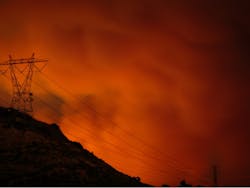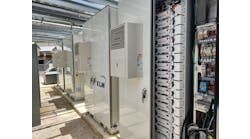Recent power shutdowns by Pacific Gas &Electric (PGE) — and the likelihood of more to come — has renewed the urgency of a microgrid feasibility study being carried out for the Northern California City of Calistoga.
California utilities undertake the shutdowns, known as Public Safety Power Shutoffs (PSPS) when wildfire risk heightens. PGE carried out its first PSPS of 2019 in June.
Clean Coalition, which is carrying out the microgrid feasibility assessment, is now working with PGE, Calistoga’s city manager and city council to scope out and design a community microgrid that will encompass a designated resilience zone to ensure electricity for critical public services and facilities during the power shutdowns, said Frank Wasko, Clean Coalition managing director.
“We’re meeting with senior city staff, and we’ll be moving forward and conducting a solar siting survey for all Calistoga. At the same time, we’re implementing stakeholder outreach with key leaders and members of the community to help guide our scoping efforts and allow us to determine an optimal system size and design that can be implemented as soon as possible,” Wasko said in an interview with Microgrid Knowledge.
Searching for the most effective, near-term solutions
Clean Coalition’s project team expects stakeholder outreach to be completed in three to four weeks, said Malini Kannan, program engineer.
“At that point, we’ll have a lot more information…project scoping will be pretty well tightened up, and we’ll be able to proceed with system sizing and design, then proceed to explore all relevant solutions,” she said in an interview.
Kannan added that Calistoga’s city leaders are looking for the most effective, near-term solutions. “So we’re going to be focusing on individual, critical facilities. We have a few front-runners, but we won’t know exactly which will be included in the feasibility assessment until the stakeholder outreach process is completed,” she told Microgrid Knowledge.
Clean Coalition announced it would be conducting a community microgrid feasibility assessment for Calistoga in January. As per the assessment’s original design, the project team will zoom in on the technical and economic aspects of deploying microgrids at five sites with an eye to connect them into a ‘microgrid of microgrids’ at some point in the future, Kannan said.
However, “the actual sites themselves are likely to change from the original ones…[and] we’ll be incorporating a resilience zone within Calistoga. The boundaries are still in development, but we have some rough guidelines regarding coverage. The goal is to develop a microgrid feasibility assessment for locations outside the resilience zone. Nothing is set in stone, but based on our conversations with [Calistoga’s] city manager, we’re operating with the hope that PGE will be able to provide PSPS backup generation within the resilience zone.”
Networked microgrid system
The feasibility assessment is in its early stages, but Clean Coalition sees a community microgrid based on networked “solar plus storage” systems as the best means of enhancing energy resilience in Calistoga, especially given the project’s heightened urgency, Kannan said.
“Given the near-term focus, it’s easiest to deploy solar and battery storage, especially at commercial facilities. There are other resources we’re exploring, such as geothermal, but we’re uncertain about time and development costs of that at present,” she said.
Diesel generators are another option that Clean Coalition will assess technically and economically, but they have high permitting costs, and can raise other issues, such as fuel costs, ready availability of supply and impact on environmental and human health. “We’ll be including diesel for sites that already include it, but we won’t be siting any new diesel generation,” Kannan said.
Utility grid interconnection tariffs figure into the Clean Coalition project team’s feasibility assessment, Wasko added. The team is researching which would be best, but they won’t be able to reach a conclusion until they finalize site selection and generation mix.
One option under consideration is California’s virtual Net Energy Metering 2 Aggregation (NEM2A) tariff. The tariff applies to a single customer with multiple meters on the same or nearby property using renewable generation to serve the aggregated load behind the meters.
More power shutdowns looming for California?
When PGE carried out its first PSPS of 2019 in June, it shut down grid service across the San Francisco Bay Area’s North Bay and Sierra Nevada foothills. The PSPS lasted 48 hours, from June 7-June 9, shutting power to 22,000 utility customers. Calistoga also received two power shutdown warnings from PGE last fall. Meteorologists expect a severe fire season for California this year, which would lead to an increase in the frequency and duration of the power shutdowns, according to Clean Coalition.
Track news about microgrid development in the wake of California’s power shutdowns. Subscribe to the free Microgrid Knowledge newsletter.







